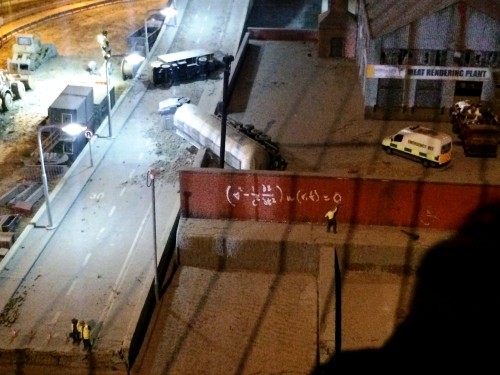By James Dacey and Tushna Commissariat
While it may seem as if we Physics World journalists spend our evenings leafing through Newton’s Principia Mathematica or deriving the Dirac equation from first principles, on Wednesday night this week, a few of us visited Dismaland – the pop-up “bemusement park” curated by the elusive British street artist Banksy. Located in the seaside town of Weston-super-Mare – a few miles south-west of the Physics World Bristol HQ – Dismaland offers a darker and more politically motivated alternative to Mickey Mouse and his friends. While our visit was not work-related, there were a few unexpected physics references that we couldn’t help but spot. First we stumbled across “The Astronauts’ Caravan”, a humorous take on the flight simulators used by NASA (see video above).
Created in 2011 by artists and engineers Tim Hunkin and Andy Plant, the outwardly unimpressive-looking theme-park ride is a compact version of the Victorian “haunted swing” illusion. We won’t spoil the magic by explaining the mechanics of the ride here, but you can read this blog by Hunkin where he explains exactly how he and Plant built their spinning caravan and if you can’t visit Dismaland, then watch the video to see what it looks like from the inside.
The other unexpected physics reference was spotted on a tiny wall of a model post-apocalyptic city – created by British artist Jimmy Cauty and entitled “The Aftermath Dislocation Principle” – seemingly populated only by a police force and other state officials. On one obscure wall of this bleak landscape, we spotted (pictured below) what appears to be a graffiti wave equation about to be erased by an authority figure – perhaps as a clamp down on the “danger” of having scientifically literate citizens?

Final wave: a bit of calculus at Dismaland. (Courtesy: James Dacey)
If Dismaland is not your sort of place, then maybe you would like to visit the CERN particle-physics lab in Geneva or Fermilab in Chicago or the KEK accelerator in Japan. If so, then sign up for this year’s “Global Physics Photowalk”. With behind-the scenes access to some of the biggest labs in the world and a chance for your photograph to win a prize that will see it published in Symmetry magazine, this is a fun day out. You can get more details and sign up here at the Interactions.org website and take a look at previous years’ photo galleries here.
For some weekend reading, check out why merely getting to work can be a bit of a chore if you work in a clean-room a mile underground, see these “5 reasons why the International Space Station should really orbit the Moon” and help the International Year of Light measure light pollution where you live by looking up at the night sky tomorrow. And finally, take a look at the latest set of stunning images of Pluto from NASA’s New Horizons probe.
Guidelines
Show/hide formatting guidelines
this text was deletedwhere people live in harmony with nature and animals</q>
Some text